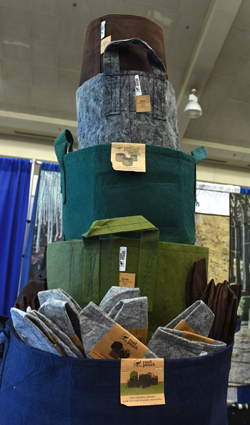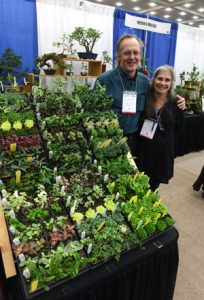Plants, pots and fun from the Mid-Atlantic Nursery Trade Show
Posted on: January 18, 2018 | Written By: Doug Oster |
Only a gardening geek can get so excited about visiting the Mid Atlantic Nursery Trade Show in Baltimore. It’s a place where all the new plants, seeds and garden items are introduced. I go to MANTS every year to see what the trends are for nurseries and to discover interesting things gardeners should know about.
CowPots

‘Purple Pearl’ is one of the interesting echeveria cultivars offered by Dummen Orange.
I stumbled onto Matt Freund, a dairy farmer from Connecticut who understands that cows make a lot of milk — but even more manure. That inspired him to find a use for all that bovine excrement, which he did with CowPots (cowpots.com).
These biodegradable containers are sold in everything from three- to 17-inch sizes. Freund spent eight years refining the process of turning manure into plant containers.
Although he said one of his goals was to remove the odor, holding a CowPot close to your nose reveals its origin. As the old saying goes, it ain’t supposed to smell like roses.
“The real goal of this project,” he says, “was environmental concerns. It helps the soil where they are planted; we do get faster maturities (too). It’s just that little bit of a boost.”
Seeds are Easy
At MANTS, I ran into Jeremy Gruszka from Avalon, the regional sales manager for 2Plant International (2plant.com). I’ve interviewed him before about Easy Bloom Pads, biodegradable paper discs that are filled with bulbs. The whole disc can be planted at once. I’ve used them and love the Bloom Pads. He had something that would be a perfect gift item for gardeners at his booth.
“Seeds are Easy is a burlap bag lined with plastic,” he says.
The bag is filled with planting mix and seeds. All it needs is water. They retail between $10 and $12 and each bag has a different herb. There are two types of bags, each one filled with a different herb. For tea, there’s chamomile, lavender, lemon balm, thyme and mint. Kitchen herbs include chives, basil, sage, parsley and others.
Root Pouches

Seeds are Easy is a new product from 2Plant International. Just add water to the pot and wait for the seeds to germinate.

Root Pouches are made out of recycled water bottles.
Recycling and caring for the environment were definitely trends at the show. Root Pouches (rootpouch.com) are fabric containers made from recycled water bottles. Ashley Fromm is one of the owners of the company that produces the pots for growers, retailers and consumers.
“The main benefit of our product is that it air prunes the roots,” she says.
In a conventional plastic pot, the roots will circle the inside of the pot; that doesn’t happen with the Root Pouch. For gardeners, the lightweight pots can be folded flat and easily stored. They come in a plethora of colors and are even pretty enough to be used indoors on a tray.
“The idea is to keep the green industry green,” Fromm says.
‘At Last’ rose
One of the most thrilling introductions from my point of view is the ‘At Last’ rose. Tough landscape roses have dominated the market in the past 10 years, but this is the first with fragrance. I’ve written about it briefly before but finally got a chance to see and smell the rose. It’s got a wonderfully delicate, sweet scent and stunning double flowers.
It’s indestructible, disease-resistant, hardy to zone five and only gets about three feet tall and wide. Natalie Carmolli, marketing and PR specialist for Proven Winner ColorChoice Shrubs (provenwinners.com), explains how the flowers change according to the weather.
“It’s generally a light orange, but in the cold the rose will turn pinker,” she says. It’s a long bloomer too and will flower all summer long.
Succulents
The Dümmen Orange (dummenorange.com) booth was filled with succulent Echeveria plants, which have become popular over the past several seasons.
Hens and chicks have been favorites for generations, but now there are a plethora of cultivars being offered and some have amazing flowers.
“It’s one of the easiest of the succulents to root,” says Jennifer Kuziw, regional sales manager. “It’s one of the easiest for the consumer to take care of at their house.”
They produce plants all over the world to sell wholesale and retail. The plants are simple to grow, a nice addition for indoor winter gardens and drought tolerant, too.
“It offers the most varieties as far as colors and textures,” Kuziw says of echeveria.
Most are grown as houseplants when it’s cold and taken out to the garden in the summer.
“They are up and coming (and) don’t need a lot of care,” she says. “The less water you give them, the happier they are.”
Deer-Leerious
The battle against deer is one that’s waged all over the country. Famed garden writer Dr. Allan Armitage is strategic advisor for the Deer-Leerious plant line (deerleeriousplants.com) available at independent garden centers.
“We did a lot of research,” he says.
It’s based on fact, he adds about the array of plants. They are divided into three categories with a No. 1 being least appetizing to the deer to No.3 that might be nibbled by the pests. Hellebores are one of the plants that are high on the list of plants that deer don’t prefer. Armitage warns though that no plant can be labeled as deer proof, but through careful study, these plants are the best at what they do.
“Deer are not going to eat these in favor of other plants in your garden,” he says. Ferns, carex, anemone, mikweed, asters and blanket flower are just some of the long list of plants the company offers.
Small plants

Hugh and Martha Meehan run Meehan’s Miniatures. They supply small plants for fairy gardens, terrariums and bonsai plantings.
Martha Meehan of Meehan’s Miniatures (meehansminiatures.com) runs the company with her husband, Hugh. For years their small plants were used with Bonsai displays to give the plants scale. With the huge popularity of fairy gardens and the resurrection of terrariums, the plants have found new life.
“It’s huge,” she says. “Before terrariums and fairy gardens you really didn’t see them much.”
They still have lots of Bonsai at their exhibit, but the tiny plants are mostly sold for the other uses.
“I love this,” she says pointing out scutilaria indica. “It’s a little flowering plant that will grow outside and inside, I like that.”
When asked how she started growing miniatures, she smiles and laughs: “I’m short. I like small things that will fit into small places.”
The couple visits Pittsburgh from Maryland annually for the Greater Pittsburgh Bonsai Show where they display and sell their plants.
“We love Pittsburgh,” she says. “I love seeing Pittsburgh clean, because I remember Pittsburgh when it was gray, and now it’s very green.”
Like most gardeners, Meehan receives therapy from her treasured diminutive plants.
“I like seeing different textures, colors in the foliage,” she says. “It’s really nice in the winter time when it’s very depressing and gray to see all this lush growth and color; that helps me get through the winter.”
Doug Oster is editor of Everybody Gardens, a website operated by 535Media, LLC. Reach him at 412-965-3278 or doster@535mediallc.com. See other stories, videos, blogs, tips and more at everybodygardens.com.
More from Everybody Gardens
See also, How To Grow Roses Organically